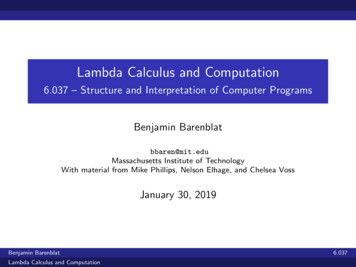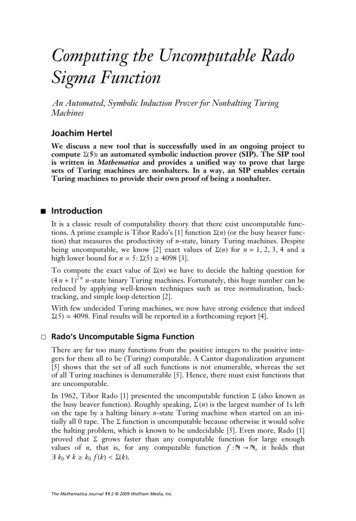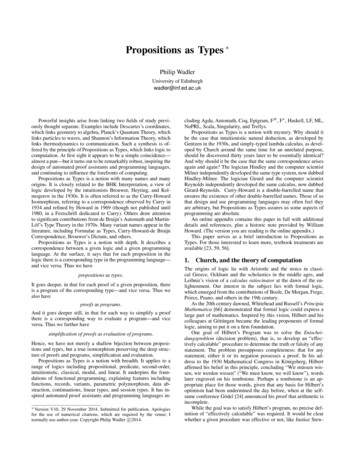
Transcription
Using Graphic Turing Tests To Counter Automated DDoS Attacks Against Web ServersWilliam G. Morein Angelos Stavrou † Debra L. Cook Angelos D. Keromytis Vishal Misra Dan Rubenstein† Department of Computer Science †Department of Electrical EngineeringColumbia University in the City of New lumbia.eduABSTRACT1. INTRODUCTIONWe present WebSOS, a novel overlay-based architecture that provides guaranteed access to a web server that is targeted by a denialof service (DoS) attack. Our approach exploits two key characteristics of the web environment: its design around a human-centricinterface, and the extensibility inherent in many browsers throughdownloadable “applets.” We guarantee access to a web server for alarge number of previously unknown users, without requiring preexisting trust relationships between users and the system.Our prototype requires no modifications to either servers or browsers, and makes use of graphical Turing tests, web proxies, andclient authentication using the SSL/TLS protocol, all readily supported by modern browsers. We use the WebSOS prototype to conduct a performance evaluation over the Internet using PlanetLab, atestbed for experimentation with network overlays. We determinethe end-to-end latency using both a Chord-based approach and ourshortcut extension. Our evaluation shows the latency increase by afactor of 7 and 2 respectively, confirming our simulation results.The Web is increasingly being used for different kinds of services and interactions with, and between humans. Beyond displaying static content such as home pages or academic papers, the webis actively used for such diverse tasks as e-mail, banking, consumerpurchasing, marketing, stock-quote dissemination and trading, andreal-time communication. The wide availability of high-qualitybrowsers and servers, as well as programmers’ and users’ familiarity with the tools and concepts behind web browsing ensure thatongoing creation of additional services.Such an environment provides a rich set of targets for motivatedattackers. This has been demonstrated by the large number of vulnerabilities and exploits against web servers, browsers, and applications. Traditional security considerations revolve around protectingthe network connection’s confidentiality and integrity, protectingthe server from break-in, and protecting the client’s private information from unintended disclosure. To that end, several protocolsand mechanisms have been developed, addressing these issues individually. However, one area that has long been neglected is thatof service availability in the presence of denial of service (DoS)attacks, and their distributed variants (DDoS).Previous approaches that address the general network DoS problem [15, 9, 31] are reactive: they monitor traffic at a target location,waiting for an attack to occur. Once the attack is identified, typically via analysis of traffic patterns and packet headers, filters maybe established in an attempt to block the offenders. The two mainproblems with this approach are the accuracy with which legitimatetraffic can be distinguished from the DoS traffic, and the robustnessof the mechanism for establishing filters deep enough in the network so that the effects of the attack are minimized.We introduce WebSOS, an adaptation of the Secure Overlay Services (SOS) architecture [20]. Our intent is to prevent congestionbased DDoS attacks from denying any user’s access to web serverstargeted by those attacks. The novel aspects of WebSOS are (a) itsuse of graphic Turing tests in lieu of strong client authentication(as was proposed in SOS) to distinguish between human users andautomated attack zombies, and (b) its transparency to browsers andservers, by taking advantage of browser extensibility.In WebSOS, the portion of the network immediately surrounding attack targets (i.e., the web servers) to be protected is protectedby high-performance routers that aggressively filter and block allincoming connections from hosts that are not approved, as shownin Figure 1. These routers are “deep” enough in the network (typically in an ISP’s POP, as we discuss in Section 3) that the attacktraffic does not adversely impact innocuous traffic. The identitiesof the small set of nodes that are approved at any particular timeCategories and Subject DescriptorsC.2.0 [Security and Protection]: Denial of Service; C.2.1 [NetworkTopology]: Overlay NetworksGeneral TermsSecurity, Reliability.KeywordsGraphic Turing Tests, Web Proxies, Java. This work is supported in part by DARPA contract No. F3060202-2-0125 (FTN program) and by the National Science Foundationunder grant No. ANI-0117738 and CAREER Award No. ANI0133829, with additional support from Cisco and Intel Corporation. Any opinions, findings, and conclusions or recommendationsexpressed in this material are those of the authors and do not necessarily reflect the views of the National Science Foundation.Permission to make digital or hard copies of all or part of this work forpersonal or classroom use is granted without fee provided that copies arenot made or distributed for profit or commercial advantage and that copiesbear this notice and the full citation on the first page. To copy otherwise, torepublish, to post on servers or to redistribute to lists, requires prior specificpermission and/or a fee.CCS’03, October 27–31, 2003, Washington, DC, USA.Copyright 2003 ACM 1-58113-738-9/03/0010 . 5.00.8
based on observed traffic statistics, determine additional information about the current configuration. We leave it as future workto explore how WebSOS can be used to protect against attacks bysuch highly specialized and sophisticated attackers. Some work inthat direction can be found in [21].is kept secret so that attackers cannot try to impersonate them topass through the filter. These nodes are picked from a set of nodesthat are distributed throughout the wide area network. This superset forms a secure overlay: any transmissions that wish to traversethe overlay must first be validated at any of the entry points of theoverlay using a Graphic Turing test to distinguish humans from attack scripts [10]. Once inside the overlay, the traffic is tunneledsecurely to one of the approved (and secret from attackers) locations that can then forward the validated traffic through the filteringrouters to the target. Thus, there are two main principles behindour design. The first principle is the elimination of communicationpinch-points, which constitute attractive DoS targets, via a combination of filtering and overlay routing to obscure the identities ofthe sites whose traffic is permitted to pass through the filter. Thesecond is the ability to recover from random or induced failureswithin the forwarding infrastructure or the secure overlay nodes.WebSOS is the first instantiation of the SOS architecture. Weuse this instantiation to evaluate the performance of the underlyingoverlay routing mechanism both in a local area scenario and overthe Internet using the PlanetLab testbed [27]. The results show thatthe average increase in end-to-end latency is a factor of 2 beyondwhat is achieved using the standard web infrastructure. We believethis modest increase is an acceptable alternative to providing noservice. Such a service can be used on an as-needed basis, andhence need not impact performance when no attack is in progress.These results validate our simulation analyses, where we used realISP topologies to determine the added average latency imposed bythe WebSOS mechanism.1.2 Paper OrganizationThe remainder of this paper is organized as follows. Section 2gives an overview of Secure Overlay Services (SOS) and graphicTuring tests, and discusses the specifics of the WebSOS architecture. In Section 3 we present our simulation results, using realISP topologies. Section 4 presents details of our prototype implementation, while Section 5 contains our performance evaluation.Section 6 discusses other work in DoS detection, prevention, andmitigation. Finally, Section 7 concludes the paper.2. THE WEBSOS ARCHITECTUREBecause our approach is based on the Secure Overlay Services(SOS) [20] architecture, we first highlight its important aspects.We also briefly describe Graphic Turing tests, which implementhuman-to-overlay authentication. We close this section with a description of WebSOS.2.1 Overview of SOSFundamentally, the goal of the SOS infrastructure is to distinguish between authorized and unauthorized traffic. The former isallowed to reach the destination, while the latter is dropped or israte-limited. Thus, at a very basic level, SOS requires the functionality of a firewall “deep” enough in the network that the accesslink to the target is not congested. This imaginary firewall performsaccess control by using protocols such as IPsec [19]. This generally pre-supposes the presence of authentication credentials (e.g.,X.509 [5] certificates) that a user can use to gain access to the overlay. We consider this one of the the largest drawbacks to SOS, as itprecludes casual access to a web server by anonymous, yet benignusers.1.1 WebSOS Architectural ScopeDoS attacks can take many forms, depending on the resource theattacker is trying to exhaust. For example, an attacker can try tocause the web server to perform excessive computation, or exhaustall available bandwidth to and from the server. In all forms, the attacker’s goal is to deny use of the service to other users. Apart fromthe annoyance factor, such an attack can prove particularly damaging for time- or life-critical services (e.g., tracking the spread ofan real-world epidemic), or when the attack persists over severaldays1 . Of particular interest are link congestion attacks, wherebyattackers identify “pinch” points in the communications substrateand render them inoperable by flooding them with large volumesof traffic. An example of an obvious attack point is the location (IPaddress) of the destination that is to be secured, or the routers inits immediate network vicinity; sending enough attack traffic willcause the links close to the destination to be congested and drop allother traffic. It is such attacks that WebSOS was designed to address. Solving the much harder general denial-of-service problemwhere attackers could potentially have enough resources to physically partition a network is not addressed in this paper. Furthermore, we do not consider algorithmic denial of service attacks [8].We assume that attackers are smart enough to exploit featuresof the architecture that are made publicly available, such as theset of nodes that form the overlay. However, we do not specifically consider how to protect the architecture against attackers whocan infiltrate the security mechanism that distinguishes legitimatetraffic from (illegitimate) attack traffic: we assume that communications between overlay nodes remain secure so that an attackercannot send illegitimate communications, masking them as legitimate. In addition, it is conceivable that more intelligent attackerscould monitor communications between nodes in the overlay ltered regionFigure 1: Basic SOS architecture. SOAP stands for Secure OverlayAccess Point, and represents an entry point to the SOS overlay. SOSnodes can serve any of the roles of SOAP, Beacon, or Secret Servlet.Since traditional firewalls themselves are susceptible to DoS attacks, what is really needed is a distributed firewall [3, 16]. Toavoid the effects of a DoS attack against the firewall connectivity,instances of the firewall are distributed across the network. Expensive processing, such as cryptographic protocol handling, is farmedout to a large number of nodes. However, firewalls depend on topological restrictions in the network to enforce access-control policies. In what we have described so far, an attacker can launch a1In one instance of a persistent DoS attack, a British ISP wasforced out of business because it could not provide service to itscustomers.9
The Chord service is robust to changes in overlay membership,and each node’s list is adjusted to account for nodes leaving andjoining the overlay such that the above properties continue to hold.SOS uses the IP address of the target (i.e., web server) as theidentifier to which the hash function is applied. Thus, Chord candirect traffic from any node in the overlay to the node that the identifier is mapped to, by applying the hash function to the target’sIP address. This node, where Chord delivers the packet, is not thetarget, nor is it necessarily the secret servlet. It is simply a uniquenode that will be eventually be reached, after up to m log Noverlay hops, regardless of the entry point. This node is called thebeacon, since it is to this node that packets destined for the targetare first guided. Chord therefore provides a robust and reliable,while relatively unpredictable for an adversary, means of routingpackets from an overlay access point to one of several beacons.Finally, the secret servlet uses Chord to periodically inform thebeacon of the secret servlet’s identity. Should the servlet for a targetchange, the beacon will find out as soon as the new servlet sendsan advertisement. If the old beacon for a target drops out of theoverlay, Chord will route the advertisements to a node closest tothe hash of the target’s identifier. Such a node will know that it isthe new beacon because Chord will not be able to further forwardthe advertisement. By providing only the beacon with the identityof the secret servlet, traffic can be delivered from any firewall tothe target by traveling across the overlay to the beacon, then fromthe beacon to the secret servlet, and finally from the secret servlet,through the filtering router, to the target. This allows the overlayto scale for arbitrarily large numbers of overlay nodes and targetsites. Unfortunately, this also increases the communication latency,since traffic to the target must be redirected several times across theInternet. If the overlay only serves a small number of target sites,regular routing protocols may be sufficient.DoS attack with spoofed traffic purporting to originate from one ofthese firewalls, whose identity cannot be assumed to remain foreversecret. The insight of SOS is that, given a sufficiently large group ofsuch firewalls, one can select a very small number of these as thedesignated authorized forwarding stations: only traffic forwardedfrom these will be allowed through the filtering router. In SOS,these nodes are called secret servlets. All other firewalls must forward traffic for the protected site to these servlets. Figure 1 givesa high-level overview of a SOS infrastructure that protects a targetnode or site so that it only receives legitimate transmissions. Notethat the secret servlets can change over time, and that multiple sitescan use the same SOS infrastructure.1307 1 : 107 2: 107 4: 127 8: 167 16: 253257221017 1: 22::171616 1: 1716 2: 2216 4: 2216 8: 2516 16: 112m 52.2 Graphic Turing TestsFigure 2: Chord-based overlay routing.In order to prevent automated attacks from breaching the overlay,a CAPTCHA [37] visual test is implemented at the entry point ofthe overlay to verify the presence of a human user. CAPTCHA(Completely Automated Public Turing test to Tell Computers andHumans Apart) is a program that can generate and grade tests thatmost humans can pass, but automated programs cannot.The particular CAPTCHA realization we use is GIMPY, whichconcatenates an arbitrary sequence of letters to form a word andrenders a distorted image of the word as shown in Figure 3. GIMPYrelies on the fact that humans can read the words within the distorted image and current automated tools cannot. The human authenticates himself/herself by entering as ASCII text the same sequence of letters as what appears in the image. Updating the GIMPYinterface to WebSOS can be performed without modifying the otherarchitectural components.Although recent advances in visual pattern recognition [24] candefeat GIMPY, there is no solution to date that can recognize complicated images or relation between images like Animal-PIX. Although for demonstration purposes in our prototype, described inSection 4, we use GIMPY, we can easily substitute it with any otherinstance of graphic turing test.To route traffic inside the overlay, SOS uses Chord [34], whichcan be viewed as a routing service that can be implemented atopthe existing IP network fabric, i.e., as a network overlay. Consistent hashing [17] is used to map an arbitrary identifier to a uniquedestination node that is an active member of the overlay.In Chord, each node is assigned a numerical identifier (ID) viaa hash function in the range [0, 2m ] for some pre-determined valueof m. The nodes in the overlay are ordered by these identifiers. Theordering is cyclic (i.e., wraps around) and can be viewed conceptually as a circle, where the next node in the ordering is the next nodealong the circle in the clockwise direction.Each overlay node maintains a table that stores the identities ofm other overlay nodes. The ith entry in the table is the node whoseidentifier x equals or, in relation to all other nodes in the overlay, most immediately follows x 2i 1 ( (mod 2m )), as shownin Figure 2. When overlay node x receives a packet destined forID y, it forwards the packet to the overlay node in its table whoseID precedes y by the smallest amount. In the example, if node 7receives a packet whose destination is the identifier 20, the packetwill route from 7 to 16 to 17. When the packet reaches node 17, thenext node in the overlay is 22, and hence node 17 knows that 22 isresponsible for identifier 20. The Chord algorithm routes packetsaround the overlay “circle”, progressively getting closer to the desired overlay node. O(m) overlay nodes are visited. Typically, thehash functions used to map nodes to identifiers do not attempt tomap two geographically close nodes to nearby identifiers. Hence,it is often the case that two nodes with consecutive identifiers aregeographically distant from one another within the network.2.3 Sequence of Operations in WebSOSTo illustrate the use of the WebSOS architecture by servers andclients, we describe the steps both sides must undertake to protecttheir communication channel: A site (target) installs a filter on a router in its immediatevicinity and then selects a number of WebSOS nodes to actas “secret servlets” that are allowed to forward traffic through10
beacon, secret servlet). If a node within the overlay is attacked,the node simply exits the overlay and the Chord service self-heals,providing new paths over the re-formed overlay to (potentially newsets of) beacons. Furthermore, no node is more important or sensitive than others — even beacons can be attacked and are allowedto fail. Finally, if a secret servlet’s identity is discovered and theservlet is targeted as an attack point, or attacks arrive at the targetwith the source IP address of some secret servlet, the target canchoose an alternate set of secret servlets.Use of GRE for encapsulating the traffic between the secret servletand the filtering router can offer an additional benefit, if we also usetransparent proxies and IPsec for packet encapsulation between theproxies (replacing SSL). In that implementation scenario, as faras the target web server is concerned the HTTP/HTTPS connection from the browser was received directly. Thus, any return TCPtraffic will be sent directly to the browser’s IP address. Followingour discussion in Section 2.4, this asymmetric connection routingwill considerably improve the end-to-end latency and reduce theload on the overlay network (less traffic to proxy). While asymmetric routing was once considered potentially harmful, empiricalstudies show that most of the long-haul traffic (e.g., non-local traffic) over the Internet exhibits high asymmetry [2]. Most of thearguments against this asymmetry arise from the difficulty of configuring packet classification mechanisms, which preclude statefulfiltering and required synchronized configuration of multiple nodes(those the traffic may traverse). This would not be a problem in ourcase, as the asymmetry is exhibited far enough in the network (beyond the filtering router) that the local administrative tasks, suchas configuring a firewall, remain unaffected. IPsec and transparentproxying techniques are well-known and (in the case of transparentproxies) widely used, thus we believe such an implementation isnot unfeasible. For the purposes of this paper, we decided to implement the straight-forward version of WebSOS; development ofthe optimized version remains in our plans for future work.In [20], the authors performed a preliminary analysis using simple networking models to evaluate the likelihood that an attackeris able to prevent communications to a particular target. This likelihood was determined as a function of the aggregate bandwidthobtained by an attacker through the exploitation of compromisedsystems. The analysis included an examination of the capabilitiesof static attackers who focus all their attack resources on a fixedset of nodes, as well as attackers who adjust their attacks to “chaseafter” the repairs that the SOS system implements when it detectsan attack. The authors demonstrated that even attackers that areable to launch massive attacks are very unlikely to prevent successful communication. For instance, attackers capable of launchingdebilitating attacks against 50% of the nodes in the overlay haveroughly one chance in one thousand of stopping a given communication from a client who can access the overlay through a smallsubset of overlay nodes. For more details on the analysis, see [20].Figure 3: WebSOS implementation of user Web Challenge usingCAPTCHA. The challenge in this case is “fwst”.the filter to the target site. Routers at the perimeter of thesite are instructed to only allow traffic from these servlets toreach the internal of the site’s network. These routers arepowerful enough to do filtering using only a small number ofrules on incoming traffic without adversely impacting theirperformance. In order to make guessing the identity of a secret servlet for a particular target harder for the attacker, thefiltering mechanism uses packet fields with potentially highentropy. For example, only GRE [12] packets from a particular source (the secret servlet) containing a specific 32-bitvalue in the GRE Key field [11]. An attacker trying to slip attack traffic through the filter must guess not only the currentservlet’s IP address, but the correct 32-bit key as well. Although we expect 32 bits to be sufficient for this application,we can easily use larger keys to avoid brute-force attacks. When a WebSOS node is informed that it will act as a secretservlet for a site (and after verifying the authenticity of therequest, by verifying the certificate received during the SSLexchange), it computes the key k for a number of well-knownconsistent hash functions, based on the target site’s networkaddress. Each of these keys will identify a number of overlaynodes that will act as beacons for that web server. Having identified the beacons, the servlets or the target willcontact them, notifying them of the servlets’ association witha particular target. Beacons will store this information anduse it for traffic-forwarding purposes. A source that wants to communicate with the target contactsa random overlay node, the Secure Overlay Access Point(SOAP). After authenticating and authorizing the request viathe CAPTCHA test, the overlay node securely proxies alltraffic from the source to the target via one of the beacons.The SOAP (and all subsequent hops on the overlay) can proxythe HTTP request to an appropriate beacon in a distributedfashion using Chord, by applying the appropriate hash function(s) to the target’s IP address to identify the next hop onthe overlay. To minimize delays in future requests, the clientis issued a short-duration X.509 certificate, bound to the SOAPand the client’s IP address, that can be used to directly contact the proxy-server component of the SOAP without requiring another CAPTCHA test.2.4 Forwarding SpecificsWebSOS uses SSL to provide two layers of encryption. First,messages are encrypted end-to-end, so that only the end-points ofthe exchange (user and web-server) can view the data actually being transmitted. Additionally, WebSOS uses SSL over each hop ofthe overlay as a means of verifying the authenticity of the previous hop. No special functionality is required by the overlay nodesto perform these tasks; the user browser simply has to be suppliedwith the appropriate certificate(s) from the WebSOS administrator.In the original SOS architecture, the path established from theuser to the target through the overlay was unidirectional. Trafficin the reverse direction could also traverse the overlay, by revers-This scheme is robust against DoS attacks because if an accesspoint is attacked, the confirmed source point can simply choose analternate access point to enter the overlay. Any overlay node canprovide all different required functionalities (SOAP, Chord routing,11
within a d-dimensional space. Each overlay node contains a tableof overlay nodes responsible for neighboring areas in the coordinate space. As shown in Figure 4, overlay node 7 would containpointers to nodes 3, 6, 8, and 11. In its basic form, CAN does notassume any relationship between node positions of the coordinatespace and their geographical positions in the real world. A variation suggested in [28] that assigns positions within the coordinatespace being representative of the geography provided the basis forthe heuristic used in the model.ing the roles of user and target. In that case, the path taken byrequests and responses would be different. Alternatively, trafficfrom the target to the user could be sent directly (without usingthe overlay); this is usually not a problem, since most communication channels are full-duplex and, in the event of a DDoS attack,only the downstream portion (to the target) is congested. An additional benefit of this asymmetric approach is reduced latency, sincemost client/server traffic (especially in web environments) is highlyasymmetric (i.e., clients receive a lot more information than theytransmit). This was possible because routing decisions in SOS aremade on a per-packet basis.In WebSOS, routing decisions are made on a per-connection basis. Any subsequent requests over the same connection (when using HTTP 1.1) and any responses from the web server can take thereverse path through the overlay. While this makes the implementation simpler, it also introduces increased latency, as the bulk ofthe traffic will also traverse the overlay. We give some thoughts onhow to address this issue in Section 5.3.2 Network LayoutA POP-level representation of the ISP was used, where each POPis assumed to consist of a hierarchy of routers as shown in Figure 5.At the top level are routers with links to other POPs. At the lowestlevel are links to client networks.to other popsOC192to other ISPsbandwidth varies12345678OC48 .OC39101112 13141516to clientstypically T3Figure 4: Overlay nodes serving regions of a coordinate-space.Figure 5: ISP POP structure used in the simulation.3.SIMULATIONLatencies between POPs were estimated from a subset of knownlatencies. Distances between POPs were estimated using airlinemiles. Three routers were included at the second level and twelve atthe lowest level of each POP; however, for the statistics computed,the exact number of routers within a POP was not relevant, only thelatency from the time a packet entered a router within a POP to thetime it left the POP was needed.The model assumes that there is ample bandwidth between POPsand that the choke points are the links to clients. All latencies anddistances to clients to their local POP are assigned the same value.There were 19 POPs in the US model and 18 in the Europemodel. Overlay nodes participating in the overlay were evenly distributed across POPs, meaning each POP served the same numberof client nodes eligible to be overlay nodes. In the cases whereservlets and beacons were randomly chosen, this allowed each POPto be equally likely to have a client site that was a servlet or beacon. In the cases where the servlet and beacon nodes were notrandomly chosen, there were more eligible nodes per POP than utilized and the even distribution did not impact selection. A node wasnot allowed to serve more than one purpose for a specific sourcetarget pair, for example, a node could not be both a beacon and aservlet for the same target. Removing the restriction would resultin shorter routes on average because some scenarios tested wouldpick the same node for both the servlet and beacon.To understand the impact of the overlay network on the routingof packets between the source and target nodes, we have applied theSOS algorithm to two models of ISP networks [7]. One model, indicative of a U.S. topology, is derived from AT&T’s U.S. backbonenetwork. The other, indicative of a European topology, is derivedfrom Worldcom’s (now MCI’s) European backbone network. Remote access points were excluded from the AT&T model, as wereconnections from Worldcom’s European POPs to points outside thegeographical area. For each model, two algorithms for routing traffic through the overlay were tested, one based on Chord, which usesa random ordering of the overlay nodes, and a heuristic variation ofCAN that uses geographical ordering of the overlay nodes. In bothcases, we tested variations on how the beacons and servlets werechosen in relation to each other, the target, and the source, e.g.,requiring some minimum distance between the servlet and target.We first give a brief description of CAN [28], and then discussthe specifics of the s
based DDoS attacks from denying any user's access to web servers targeted by those attacks. The novel aspects of WebSOS are (a) its use of graphic Turing tests in lieu of strong client authentication (as was proposed in SOS) to distinguish between human users and automated attack zombies, and (b) its transparency to browsers and










